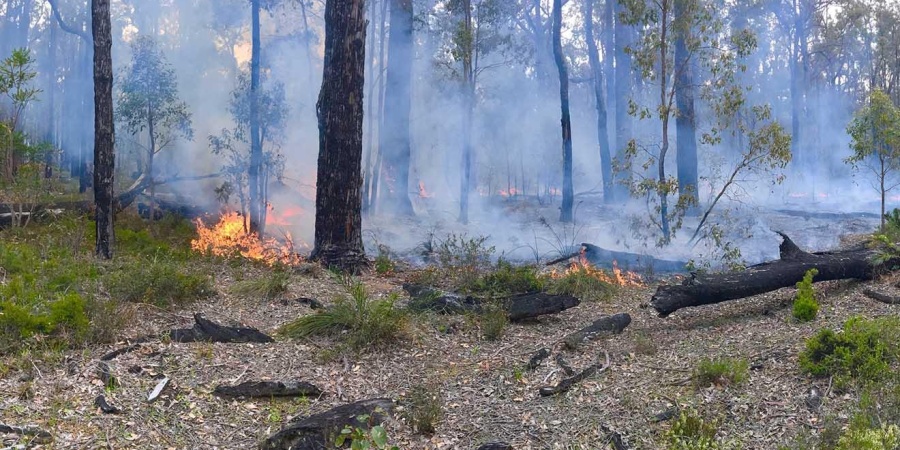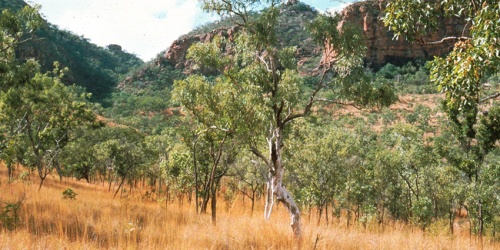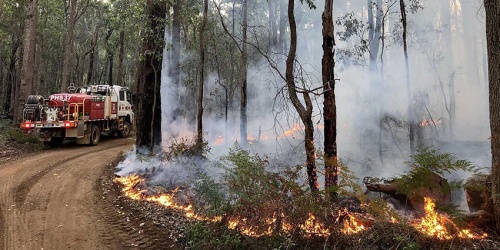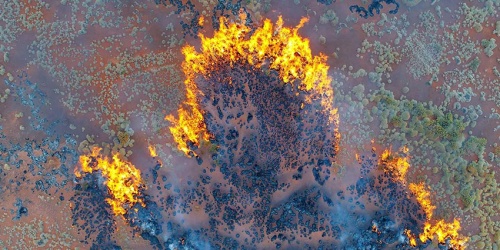
Prescribed burn at Noggerup. Photo – Ed Hatherley DBCA
Plant communities in Australia are adapted to persist and reproduce in a fire-prone environment.
Plant species have a range of adaptations that help them to persist through fire. These may either involve populations re-colonising after fire through dispersal, populations regenerating from seed banks that survive fire, or individuals resprouting from buds and tissues that survive fire. Most Western Australian plants use one or both of the last two mechanisms, but a few, such as mistletoes, rely only on dispersal.
Banksia woodland
Abbott, I. and N. Burrows (2003). Fire in ecosystems of south-west Western Australia: impacts and management, Department of Conservation and Land Management, WA. Published by Leiden: Backhuys Publishers. pp. 225–68. ISBN 90-5782-131-1.
Burrows, N. (2008). "Linking fire ecology and fire management in south-west Australian forest landscapes." Forest Ecology and Management 225: 2394- 2406.
Ruthrof, K., B. Miller, J. Fontaine, N. Enright, R. Miller and R. Tangney (2018). "Prescribed burning in Perth’s bushlands: where, when and how much?" For People & Plants 101 (Autumn 2018).
Valentine, L. E., B. A. Wilson, A. Reaveley, N. Huang, B. Johnson and P. Brown (2009). Patterns of ground-dwelling vertebrate biodiveristy in the Gnangara sustainability strategy study area, Draft Report to the WA Department of Environment and Conservation and the Gnangara Sustainability Strategy, Department of Parks and Wildlife, Crawley, WA.
Valentine, L. E., K. Bleby, M. Swinburn, J. Kinloch and B. Wilson (2009). Chapter Two: Floristic biodiversity and vegetation condition, in: Wilson, B.A., Valentine, L.E. (Eds.) Biodiversity values and threatening processes of the Gnangara groundwater system. A report to the Gnangara Sustainability Strategy and the Department of Environment and Conservation, Perth, Australia. (http://www.water.wa.gov.au/sites/gss/reports.html).
Wilson, B., J. Keuhs and L. Valentine (2010). Guidelines for Developing Ecological Burning Regimes for the Gnangara Groundwater System, Report for the Gnangara Sustainability Strategy and the Department of Environment and Conservation. Department of Water, Perth, WA.
Forest
Burbidge AH (2003). Birds and fire in the Mediterranean climate of south-west Western Australia. In Fire in Ecosystems of South-West Western Australia: Impacts and Management Backhuys, Leiden. pp. 321–347
Burrows, N. (2008). "Linking fire ecology and fire management in south-west Australian forest landscapes." Forest Ecology and Management 225: 2394- 2406.
Burrows, N. and McCaw, L. (2013). Prescribed burning in south west Australian forests. Frontiers in Ecology and the Environment. Special online edition.
Friend, G. and Wayne, A. (2003) Relationships between mammals and fire in south-west Western Australian ecosystems: what we know and what we need to know. Fire in ecosystems of south-west Western Australia: Impacts and management, pp. 363-280.
Wittkuhn RS, McCaw WL, Wills AJ, et al. 2011. Variation in fire interval sequences has minimal effects on species richness and composition in fire-prone landscapes of south-west Western Australia. Forest Ecol Manag 261: 965–78.
Hummock grassland
Burrows, N., Rampant, P., Loewenthal, G. and Wills., A (2020) Fire, plant species richness and plants of significance to Australian desert Aboriginal people. International Journal of Wildland Fire, 29: 939-942.
Burrows, N and Ward, B.G., (2009) Fuel dynamics and fire in Spinifex grasslands of the Western desert. Proceedings of the Royal Society of Queensland, 115: 69-76.
Pianca, E.R., and Goodyear, S.E (2012) Lizard responses to wildfire in arid interior Australia: Long-term experimental data and commonalities with other studies. Austral Ecology 37: 1-11.
Tropical savanna
Andersen AN, Bocciarelli D, Fairman R, Radford IJ (2014). Conservation status of ants in an iconic region of monsoonal Australia: levels of endemism and responses to fire in the eastern Kimberley. Journal of Insect Conservation 18, pp. 137–146
Clarke, P.J., Lawes., M.J., Murphy., B.P., Russell-Smith, J., Nano, C.E., Bradstock., R., Enright., N.E., Fontaine., J.B., Gosper., C.R., Radford., I., Midgley., J.J., and Gunton., R.M. (2015) A synthesis of postfire recovery traits of woody plants in the Australian ecosystems. Science of the Total Environment 534: 21-42
Hohnen R, Tuft KD, Legge S, Radford IJ, Carver S, Johnson CN (2015). Post-fire habitat use of the golden-backed tree-rat (Mesembriomys macrurus), in the northwest Kimberley, Western Australia. Austral Ecology 40, pp. 941–952
Radford IJ, Woolley L-A, Corey B, Vigilante T, Wunambal Gaambera Aboriginal Corporation, Hatherley E et al. [Fairman R, Start AN] (2020). Prescribed burning benefits threatened mammals in northern Australia. Biodiversity and Conservation 29, pp. 2985–3007
Radford IJ, Andersen AN, Graham G, Trauernicht C (2013). The fire refuge value of patches of a fire-sensitive tree in fire-prone savannas: Callitris intratropica in northern Australia. Biotropica 45, pp. 594–601
Radford IJ (2012). Threatened mammals become more predatory after small-scale prescribed fires in a high-rainfall rocky savanna. Austral Ecology 37, pp. 926–935
Radford IJ, Andersen AN (2012). Effects of fire on grass-layer savanna macroinvertebrates as key food resources for insectivorous vertebrates in northern Australia. Austral Ecology 37, pp. 733–742
Radford I, White K (2008). Fire in the Kimberley: natural phenomenon or natural disaster?. Landscope 23(3), pp. 22–28
Vigilante., T. and Bowman., D. (2004) Effects of individual fire events on the flower production of fruit-bearing tree species, with reference to Aboriginal peoples management and use, at Kalumburu, North Kimberly, Australia. Australian Journal of Botany 52: 405-416.
Weier A, Radford IJ, Bellairs SM, Lawes MJ (2019). Seed set in Sorghum stipoideum, and not fire, determines the timing of breeding by Gouldian finches (Erythrura gouldiae). Austral Ecology 44, pp. 151–162
Wheatbelt
Gosper, C.R., Yates. C.J., Prober, S.M., and Blair, C. (2011) Contrasting changes in vegetation structure and diversity with time since fire in two Australian Mediterranean‐climate plant communities. Austral Ecology 37 (2): 164-174.
Parsons., B.C., and Gosper., C.R. (2011) Contemporary fire regimes in a fragmented and an unfragmented landscape: implications for vegetation structure and persistence of the fire-sensitive malleefowl. International Journal of Wildland Fire, 20: 184-194.
Shedley, E., (2007) Fire and Biodiversity Guidelines for the Avon Basin. Avon Catchment Council and Department of Environment and Conservation, Western Australia.
Woodlands
Gosper, C.R., Prober, S.M., Yates, C.J. and Wiehl, G. (2013) Estimating the time since fire of long-unburnt Eucalyptus salubris (Myrtaceae) stands in the Great Western Woodlands. Australian Journal of Botany 61, 11-21.
Gosper, C.R., Yates, C.J. and Prober, S.M. (2013) Floristic diversity in fire-sensitive eucalypt woodlands shows a ‘U’-shaped relationship with time since fire. Journal of Applied Ecology 50, 1187-1196.
Gosper, C.R., Yates, C.J., Prober, S.M., and Wiehl, G. (2014) Application and validation of visual fuel hazard assessments in dry Mediterranean-climate woodlands. International Journal of Wildland Fire 23, 385-393.
McCaw L, Reynen V, Zdunic K, Peace M (2014) Reconstructing the spread of landscape-scale fires in semi-arid southwestern Australia. In: Advances in Forest Fire Research (ed DX Viegas), pp. 912-920. Imprensa da Universidade de Coimbra, Coimbra.
McCaw L. & Hanstrum B. (2003) Fire environment of Mediterranean south-west Western Australia. In: Fire in Ecosystems of south-west Western Australia: Impacts and Management (eds I. Abbott & N. Burrows) pp. 87-106. Backhuys Publishing, Leiden.
O’Donnell, A.J., Boer, M.M., McCaw, W.L., and Grierson, P.F. (2010). Vegetation and landscape connectivity control wildfire intervals in unmanaged semi-arid shrublands and woodlands in Australia. Journal of Biogeography, 38, 112-124
O’Donnell, A.J., Boer, M.M., McCaw, W.L., and Grierson, P.F. (2014). Vegetation type and fuel age control wildfire size in semi-arid southwest Australia. Ecosphere 5(7), Article 93.
Parsons, B.C. and Gosper, C.R. (2011) Contemporary fire regimes in a fragmented and an unfragmented landscape: implications for vegetation structure and persistence of the fire-sensitive malleefowl. International Journal of Wildland Fire 20, 184-194.
Prober, S.M., Yuen, E., O’Connor, M.H. & Shultz, L. (2013). Ngadju kala: Ngadju fire knowledge and contemporary fire management in the Great Western Woodlands. CSIRO Ecosystem Sciences, Floreat, WA.
Yates, C.J., Hobbs, R.J. & Bell, R.W. (1994) Landscape-scale disturbances and regeneration in semi-arid woodlands of southwestern Australia. Pacific Conservation Biology, 1, 214–221.
Resprouting
Resprouting means that individuals can survive fire to regrow new leaves and branches, and some to flower and produce seeds, quickly after fire. It requires a ‘bank’ of dormant buds that are insulated from fire, and stored energy to enable growth. Buds are protected under soil or thick bark, and energy can be stored as starch or sugars, sometimes in specialised organs such as tubers. Resprouting enables plants to have a longevity greater than the fire interval and some to grow to large sizes. Trees of northern savannahs, Banksia woodlands and Jarrah forests have these traits. Many native orchids, sundews and lilies survive even hot summer fires, with dormant bulbs and tubers protected underground.
Seedbanks
Another important way of surviving fire, even if adult plants are killed, is via seed. A long-lived seedbank is a common feature of many Australian plants. These seedbanks can be stored in the soil or stored in the plant’s canopy in woody fruits – gumnuts, casuarina and banksia are common examples. The heat from fire promotes the opening of these woody fruits in the canopy, releasing seeds to enable dispersal and germination. Heat, or chemicals in smoke, also trigger dormancy release, and cue germination of soil stored seeds[KO1]. This mass recruitment is often cued to coincide with seasonal rains and can result in dense regrowth after fire. For some resprouting species, fire also stimulates flowering, so it is common to see grasstrees, some orchids and other species flowering strongly after fire. The orchid Pyrorchis nigricans flowers only in the year after fire.
Fire as a regenerative tool
In some situations, fire can also be an ecologically friendly and cost-effective tool to help regenerate and rehabilitate vegetation on degraded sites. It helps new seedlings by temporarily reducing competition from established vegetation and creating ash beds suitable for germination, but can also promote the establishment of weeds, so may need to be followed up with herbicide or other weed management practices. Except for areas where weed loads are low, incorporating weed management where burning has occurred or is planned may be essential to prevent further invasion and degradation.
Map of biomes and fire ecology in Western Australia
Western Australia has a broad array of climates and geographical features, which together influence what flora and fauna inhabit these areas. Using geological and climate features and the associated native vegetation, Western Australia can be divided into 27 Interim Biogeographic Regionalisation of Australia (IBRA) regions. IBRA is one of the key tools used by the government to identify land for conservation under the National Reserve system. You can find out more about IBRAs on the Department of Agriculture, Water and the Environment website.
The physical structure and type of vegetation in an area reflect the underlying climate and geography. Thus, the dominant type of vegetation can be used to simplify the 27 IBRA regions in WA into biomes.
As fire ecology will be broadly similar across the dominant vegetation type, biomes are useful ways to categorise fire ecology. Click on the map below to find out about fire ecology in each biome.
Links to scientific research referred to in the map
Banksia woodland
Abbott, I. and N. Burrows (2003). Fire in ecosystems of south-west Western Australia: impacts and management, Department of Conservation and Land Management, WA. Published by Leiden: Backhuys Publishers. pp. 225–68. ISBN 90-5782-131-1.
Burrows, N. (2008). "Linking fire ecology and fire management in south-west Australian forest landscapes." Forest Ecology and Management 225: 2394- 2406.
Ruthrof, K., B. Miller, J. Fontaine, N. Enright, R. Miller and R. Tangney (2018). "Prescribed burning in Perth’s bushlands: where, when and how much?" For People & Plants 101 (Autumn 2018).
Valentine, L. E., B. A. Wilson, A. Reaveley, N. Huang, B. Johnson and P. Brown (2009). Patterns of ground-dwelling vertebrate biodiveristy in the Gnangara sustainability strategy study area, Draft Report to the WA Department of Environment and Conservation and the Gnangara Sustainability Strategy, Department of Parks and Wildlife, Crawley, WA.
Valentine, L. E., K. Bleby, M. Swinburn, J. Kinloch and B. Wilson (2009). Chapter Two: Floristic biodiversity and vegetation condition, in: Wilson, B.A., Valentine, L.E. (Eds.) Biodiversity values and threatening processes of the Gnangara groundwater system. A report to the Gnangara Sustainability Strategy and the Department of Environment and Conservation, Perth, Australia. (http://www.water.wa.gov.au/sites/gss/reports.html).
Wilson, B., J. Keuhs and L. Valentine (2010). Guidelines for Developing Ecological Burning Regimes for the Gnangara Groundwater System, Report for the Gnangara Sustainability Strategy and the Department of Environment and Conservation. Department of Water, Perth, WA.
Forest
Burbidge AH (2003). Birds and fire in the Mediterranean climate of south-west Western Australia. In Fire in Ecosystems of South-West Western Australia: Impacts and Management Backhuys, Leiden. pp. 321–347
Burrows, N. (2008). "Linking fire ecology and fire management in south-west Australian forest landscapes." Forest Ecology and Management 225: 2394- 2406.
Burrows, N. and McCaw, L. (2013). Prescribed burning in south west Australian forests. Frontiers in Ecology and the Environment. Special online edition.
Friend, G. and Wayne, A. (2003) Relationships between mammals and fire in south-west Western Australian ecosystems: what we know and what we need to know. Fire in ecosystems of south-west Western Australia: Impacts and management, pp. 363-280.
Wittkuhn RS, McCaw WL, Wills AJ, et al. 2011. Variation in fire interval sequences has minimal effects on species richness and composition in fire-prone landscapes of south-west Western Australia. Forest Ecol Manag 261: 965–78.
Hummock grassland
Burrows, N., Rampant, P., Loewenthal, G. and Wills., A (2020) Fire, plant species richness and plants of significance to Australian desert Aboriginal people. International Journal of Wildland Fire, 29: 939-942.
Burrows, N and Ward, B.G., (2009) Fuel dynamics and fire in Spinifex grasslands of the Western desert. Proceedings of the Royal Society of Queensland, 115: 69-76.
Pianca, E.R., and Goodyear, S.E (2012) Lizard responses to wildfire in arid interior Australia: Long-term experimental data and commonalities with other studies. Austral Ecology 37: 1-11.
Tropical savanna
Andersen AN, Bocciarelli D, Fairman R, Radford IJ (2014). Conservation status of ants in an iconic region of monsoonal Australia: levels of endemism and responses to fire in the eastern Kimberley. Journal of Insect Conservation 18, pp. 137–146
Clarke, P.J., Lawes., M.J., Murphy., B.P., Russell-Smith, J., Nano, C.E., Bradstock., R., Enright., N.E., Fontaine., J.B., Gosper., C.R., Radford., I., Midgley., J.J., and Gunton., R.M. (2015) A synthesis of postfire recovery traits of woody plants in the Australian ecosystems. Science of the Total Environment 534: 21-42
Hohnen R, Tuft KD, Legge S, Radford IJ, Carver S, Johnson CN (2015). Post-fire habitat use of the golden-backed tree-rat (Mesembriomys macrurus), in the northwest Kimberley, Western Australia. Austral Ecology 40, pp. 941–952
Radford IJ, Woolley L-A, Corey B, Vigilante T, Wunambal Gaambera Aboriginal Corporation, Hatherley E et al. [Fairman R, Start AN] (2020). Prescribed burning benefits threatened mammals in northern Australia. Biodiversity and Conservation 29, pp. 2985–3007
Radford IJ, Andersen AN, Graham G, Trauernicht C (2013). The fire refuge value of patches of a fire-sensitive tree in fire-prone savannas: Callitris intratropica in northern Australia. Biotropica 45, pp. 594–601
Radford IJ (2012). Threatened mammals become more predatory after small-scale prescribed fires in a high-rainfall rocky savanna. Austral Ecology 37, pp. 926–935
Radford IJ, Andersen AN (2012). Effects of fire on grass-layer savanna macroinvertebrates as key food resources for insectivorous vertebrates in northern Australia. Austral Ecology 37, pp. 733–742
Radford I, White K (2008). Fire in the Kimberley: natural phenomenon or natural disaster?. Landscope 23(3), pp. 22–28
Vigilante., T. and Bowman., D. (2004) Effects of individual fire events on the flower production of fruit-bearing tree species, with reference to Aboriginal peoples management and use, at Kalumburu, North Kimberly, Australia. Australian Journal of Botany 52: 405-416.
Weier A, Radford IJ, Bellairs SM, Lawes MJ (2019). Seed set in Sorghum stipoideum, and not fire, determines the timing of breeding by Gouldian finches (Erythrura gouldiae). Austral Ecology 44, pp. 151–162
Wheatbelt
Gosper, C.R., Yates. C.J., Prober, S.M., and Blair, C. (2011) Contrasting changes in vegetation structure and diversity with time since fire in two Australian Mediterranean‐climate plant communities. Austral Ecology 37 (2): 164-174.
Parsons., B.C., and Gosper., C.R. (2011) Contemporary fire regimes in a fragmented and an unfragmented landscape: implications for vegetation structure and persistence of the fire-sensitive malleefowl. International Journal of Wildland Fire, 20: 184-194.
Shedley, E., (2007) Fire and Biodiversity Guidelines for the Avon Basin. Avon Catchment Council and Department of Environment and Conservation, Western Australia.
Woodlands
Gosper, C.R., Prober, S.M., Yates, C.J. and Wiehl, G. (2013) Estimating the time since fire of long-unburnt Eucalyptus salubris (Myrtaceae) stands in the Great Western Woodlands. Australian Journal of Botany 61, 11-21.
Gosper, C.R., Yates, C.J. and Prober, S.M. (2013) Floristic diversity in fire-sensitive eucalypt woodlands shows a ‘U’-shaped relationship with time since fire. Journal of Applied Ecology 50, 1187-1196.
Gosper, C.R., Yates, C.J., Prober, S.M., and Wiehl, G. (2014) Application and validation of visual fuel hazard assessments in dry Mediterranean-climate woodlands. International Journal of Wildland Fire 23, 385-393.
McCaw L, Reynen V, Zdunic K, Peace M (2014) Reconstructing the spread of landscape-scale fires in semi-arid southwestern Australia. In: Advances in Forest Fire Research (ed DX Viegas), pp. 912-920. Imprensa da Universidade de Coimbra, Coimbra.
McCaw L. & Hanstrum B. (2003) Fire environment of Mediterranean south-west Western Australia. In: Fire in Ecosystems of south-west Western Australia: Impacts and Management (eds I. Abbott & N. Burrows) pp. 87-106. Backhuys Publishing, Leiden.
O’Donnell, A.J., Boer, M.M., McCaw, W.L., and Grierson, P.F. (2010). Vegetation and landscape connectivity control wildfire intervals in unmanaged semi-arid shrublands and woodlands in Australia. Journal of Biogeography, 38, 112-124
O’Donnell, A.J., Boer, M.M., McCaw, W.L., and Grierson, P.F. (2014). Vegetation type and fuel age control wildfire size in semi-arid southwest Australia. Ecosphere 5(7), Article 93.
Parsons, B.C. and Gosper, C.R. (2011) Contemporary fire regimes in a fragmented and an unfragmented landscape: implications for vegetation structure and persistence of the fire-sensitive malleefowl. International Journal of Wildland Fire 20, 184-194.
Prober, S.M., Yuen, E., O’Connor, M.H. & Shultz, L. (2013). Ngadju kala: Ngadju fire knowledge and contemporary fire management in the Great Western Woodlands. CSIRO Ecosystem Sciences, Floreat, WA.


